Home / Compare Travel Insurance / Your guide to backpackin…
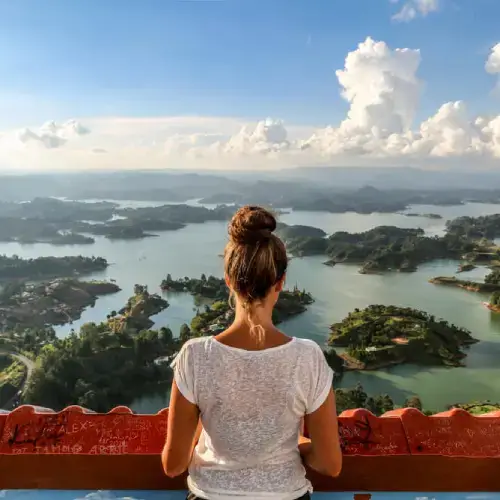
Key takeaways
- From Brazil to Argentina, South America has a number of countries to visit, all that come with their own adventures, but also their own risks.
- South America also has two non-sovereign states, plus some lesser-known South American countries like Guyana, Paraguay, Uruguay and Suriname.
- When travelling to different countries, it’s important to be aware of potential dangers and how best to stay safe on your journey.
Choosing the right travel insurance for backpacking in South America
Due to the range of countries on the South American continent, things like the standard of medical care, potential natural disasters and risk of theft can vary. That’s why Compare the Market’s travel insurance expert, Adrian Taylor, has some tips on choosing a travel insurance policy to accompany you on your journey.

Protect your pre-paid bookings
It’s important to purchase a comprehensive travel insurance policy as soon as you pay any deposits for your trip. That way, if an unforeseen event means you need to cancel some or all of your trip, you may have access to cancellation cover.
Ensure you’ve got the cover you need
Backpacking can come with the risk of injury of illness while travelling. Often, medical expenses can set you back hundreds, if not thousands, of dollars, especially when you’re overseas without Medicare or private health insurance and need repatriation or emergency evacuation. Your policy can also cover cancellations, luggage, rental vehicle excess and the option for extra cover for snow and adventure sports.
Compare policies with COVID-19 cover
When searching for a policy using Compare the Market’s comparison service, look for the COVID-19 icon. This will allow you to compare products that will cover you for COVID-19 related losses. Keep in mind, this cover may only be available with top tier policies.
Understanding how to backpack in South America
What to know about backpacking in South America
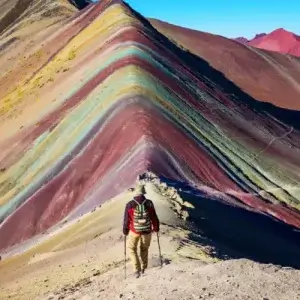
First-time backpackers and visitors to South America should do their research before leaving home, so they can be as prepared as possible for anything that comes their way. Here’s some tips to keep in mind before departing:
- Brush up on your languages. Spanish and Portuguese are the two main spoken languages in South America. Communication, especially in rural areas, may be difficult even with a smattering of travel guidebook Spanish.
- Don’t overpack your itinerary. When planning backpacking routes in South America, understand that not all trips can be day trips and may include a lot of long bus journeys. For example, visiting Machu Picchu can take a week, and trips to the Amazon are typically four days at a minimum. That said, it’s important to still have an itinerary to help keep you on track and on budget.
- Be aware fulfilling dietary requirements may be difficult. If your dietary requirements include no meat, you might struggle to find appropriate meals, especially outside big cities. South American cuisine varies widely; however, one constant is that vegetarian options may be limited and difficult to come by.
However, the challenges of South America will pale in comparison to touring some of the world’s greatest historical, cultural and natural wonders.
Backpacking in South America on a budget
Dreaming of hitting all your bucket list South American destinations is one thing, but affording it is another. Although South America may be considered ‘cheap’ by some backpacking standards, it’s typically more expensive than other backpacking destinations like Central America and Southeast Asia.
A few travel tips for saving money include:
- Cook when you can. Try to buy food at local grocers and cook your dinner a few nights per week. Choosing accommodation with kitchen facilities may cost a little extra per night, but the money saved by cooking for yourself balances this out in your favour.
- Research exchange rates. Get an idea of the different exchange rates when budgeting for each country, as some might prove more expensive than others. Your hostel, for example, might offer less favourable exchange rates than a local exchange shop.
- Opt for a dorm instead when you can. Sleeping in dorm can be beneficial if you’re on a tight budget, but if you’re travelling alone, private rooms in youth hostels may provide extra luxuries and security in an unfamiliar place.
- Take public transport. Local bus rides can be a cheap way of travelling; they aren’t always reliable, though, so it’s good to have a back-up plan.
- Plan accommodation ahead. Consider booking in advance for events like Carnivale. Hostel accommodation outside of urban centres may be smaller and less-equipped – be prepared to spend more than one night without hot water!
- Consider guided tours. Guided tours offer first-time visitors a great introduction to an area and often use local travel guides to take visitors to places that you, as a lone backpacker, wouldn’t know about or be able to get to. Certain places, like the Amazon, can be almost impossible to enter without being on a guided tour anyway.
- Compare and purchase travel insurance. Apart from your passport, travel insurance is the next most important item to consider for your South American backpacking adventure. If your belongings get stolen or you contract an illness, travel insurance can help cover the financial losses you may face.
What to pack for backpacking in South America
When planning to travel for weeks or months, it’s important not to overpack and only take what you need. When packing for your South American adventure, here are some things to keep in mind:
- Clothes. Be sure to pack your basics, but a waterproof jacket, a warm fleece jacket for cold days, swimmers and one or two nicer outfits can also be important. Check what the weather will be like before departing to get a better idea of the best clothes to bring.
- Shoes. A pair of hiking boots is a necessity in South America. You’ll also want some sandals and a pair of joggers for colder or less active days.
- Toiletries. Beyond your essentials, you should consider packing items like sunscreen, insect repellent and a basic medical kit. Be sure to also pack any necessary medication, but make sure you check any rules and regulations about taking medication to your destinations.
- Electronics. The fewer electronics you take, the less you’ll be a target for thieves, so choose wisely before taking your laptop or Kindle along. However, you should take your phone, a universal adapter, a power bank, headphones and a camera to record memories of your trip.
- Other necessities. A silk sleeping bag liner as a barrier if you plan to camp and hire a sleeping bag. You might also include a Spanish and Portuguese phrasebook, travel cutlery, your passport (and photocopies of it), visa documentation and, of course, travel insurance.
Keep in mind that this list is a basic example of a packing list for South America and will vary depending on your individual needs and your itinerary. Check out our full guide on what to pack for your overseas trip.
Keeping safe while backpacking in South America
South America is wonderful place to visit. However, many tourist areas are also crime hotspots, so it’s important to stay alert when in public and protect your belongings with travel insurance.
Your travel policy can also help cover you for other unexpected events that impact your trip. Whether it’s altitude sickness in Peru, malaria in the Amazon or falling off your mountain bike on Yungas Road, you may be covered for medical expenses, cancellation costs due to missed tours and more.
If you’re looking to keep your journey going through Central America, keep travelling upwards to the USA, Mexico and Canada, or even travel the well-trodden path through Europe, a comprehensive travel insurance policy can keep you financially protected against the unexpected.
In general, it’s a good idea to use common sense and not take unnecessary risks when backpacking in South America. If you can, backpack with a friend or join a group of like-minded travellers; you can usually find safety in numbers. Keep your passport, ID documents and money on you at all times and don’t wear flashy jewellery or clothes. Bureaucracy and corruption are also rife in certain parts of South America, so ensure your paperwork (including visas, transit stamps and passport validity) is in order before leaving Australia.
Places to visit in South America
Argentina
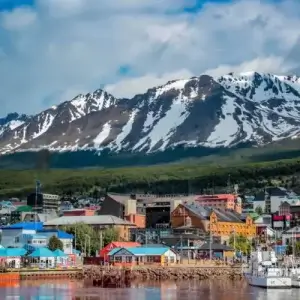
Famous for steak, red wine and their staple snack of empanadas, Argentina’s also well known for inventing the fiery dance of lovers – the Tango! Spanish is the official language, and pesos are the currency. Top spots for your backpacking trip in Argentina include:
- Buenos Aires – the city that never sleeps, with endless nightclubs and secret cocktail bars for you to discover
- Iguazu Falls – an enormous, breathtaking waterfall bordering Argentina and Brazil
- Mendoza – wine country, also known for excellent hiking and skiing in winter
- El Calafate – a highlight of the Patagonia region, it’s a small village at the foot of the Perito Moreno Glacier, which is a UNESCO world heritage site
- Ushuaia – the southernmost city in the world and a common jumping-off place for Antarctic cruise tours.
Safety tips: Major cities, tourist locations and public transport are hotspots for theft and robberies, so be cautious in those areas and keep personal belongings out of sight.1 Don’t use ATMs unless you’re in a shopping centre or bank and never at night.
Bolivia
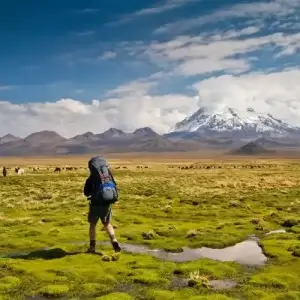
Often referred to as the Tibet of the Americas, Bolivia is one of the most remote countries in the Western Hemisphere. The currency is Boliviano and the official language is Spanish, although Bolivian Indigenous languages may be more common in rural and remote communities.
Learning Spanish in a homestay situation is popular with visiting tourists and, as such, homestay programs in Bolivia abound and are usually very safe and reputable. Top spots for backpacking in Bolivia include:
- La Paz – Bolivia’s capital and the highest capital city in the world, sitting at 4,100 metres
- The Amazon – you can get to the Amazon rainforest in Bolivia, and it offers some of the best, most accessible wildlife viewing
- Salar de Uyuni – the stunning Bolivian salt flats.
Safety tips: Don’t hail taxis off the street, as criminals often pose as drivers.2 You should avoid political protests, as they can become violent. It’s not recommended to go on hiking trips without an experienced tour guide, and if travelling between November and March, natural disasters such as flooding and landslides may occur, so follow the advice of the local government officials.
Brazil
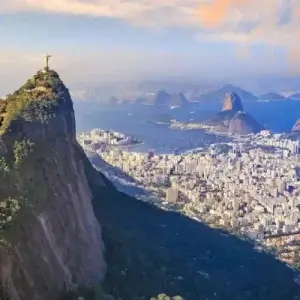
Famous for Rio’s Carnivale, long stretches of beautiful beaches and the Amazon rainforest, Brazil offers visitors a wealth of cultural, historical and natural must-see destinations. Portuguese is the official language, the official currency is the Brazilian Real and football is the unofficial religion.
Brazil is a vast country, with the top spots for backpacking in Brazil including:
- Rio de Janeiro – famous for the Christ the Redeemer statue and lively Copacabana, it’s a bustling urban centre full of nightlife, shopping and eating
- Iguazu Falls – you can access them via Brazil or Argentina
- Florianopolis – a touch of Ibiza in South America with gorgeous beaches to either relax or try your hand at surfing
- Manaus – a port city in the heart of the Amazon, not only the perfect place from which to explore the Amazon but also a historic centre with stunning architecture
- Sao Paulo – a vibrant city filled with cultural wonder, like the colourful graffiti-lined streets of Beco do Batman (Batman’s Alley).
Safety tips: During the rainy season, flooding, landslides and severe storms are common, so be prepared to make unexpected changes to your travel plans.3 It’s best to avoid going out alone, especially at night, and try to avoid travelling through ‘favelas’ or shantytowns.
Chile
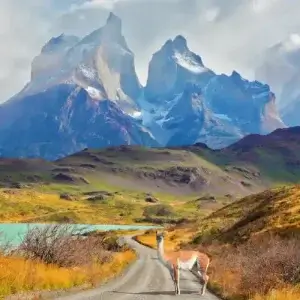
Famous for its volcanos, glaciers and fjords, Chile is sandwiched between the Andes Mountains and the Pacific Ocean. It’s only 180km wide at its widest point, but the coastline covers more than 4,300 kilometres, earning Chile the nickname of the world’s longest country.
Spanish is the primary language, and the currency is the Chilean Peso. The capital Santiago is a small, thriving, cosmopolitan city. It’s also making a name for itself as a foodie’s dream with plentiful markets, artisan produce and an array of exciting restaurants, not to mention Chile’s world-renowned wines.
Top spots for backpacking in Chile include:
- Santa Cruz and San Fernando – world-class wine regions with some of the best (and most economical) vintages in South America
- Parque Nacional Torres Del Paine – a stunning national park set amidst imposing granite towers, perfect for hiking
- Valparaíso – a bohemian haven of colourful houses, cobbled streets and Pacific Ocean views
- San Pedro de Atacama – Surrounded by the Atacama desert, you can visit the Valle de la Luna, go stargazing, or soak in the hot springs to rest your travel-weary bones
- Easter Island – also known as Rapa Nui, it’s a tiny island off the Chilean coast known for its mysterious Maoi statues.
Safety tips: It’s best to avoid political protests as they can become violent.4 Robberies and petty theft can be common, so it’s best to stay alert on public transport and not travel at night. A variety of natural disasters are also common in Chile, so be sure to follow the advice of local authorities if one occurs.
Colombia
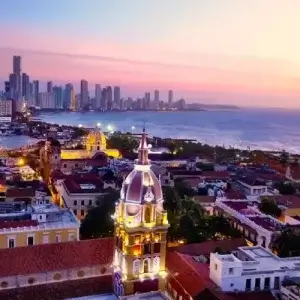
Colombia is considered one of the world’s megadiverse countries. Spanish (and, in urban centres, English) is the official language, and the Colombian Peso is the currency. Colombia’s famous for coffee and its wealth of natural resources; it’s the world’s leading source of emeralds.
Top spots for backpacking in Colombia include:
- Caño Cristales – Sometimes known as the river of five colours, or the rainbow river, it’s a visual marvel
- Cartagena – you can’t miss this colourful, coastal, colonial port city
- Bogota – full of historic churches, stunning architecture and the famous statue of Simón Bolívar
- The Salt Cathedral of Zipaquira – a architectural wonder built inside an old salt mine 200 metres below ground
- Medellin – the second-largest city in Colombia, located within the Andean mountains with phenomenal views from the Metro Cable
- Tayrona National Park – hike through rich wildlife, camp on the beach or stay in a jungle hut and enjoy the perfect tropical getaway.
Safety tips: Colombia has high levels of crime, terrorism and kidnapping in some parts of the country.5 Check Smartraveller for places you may want to reconsider travelling to or avoiding altogether. If you want to go hiking, hire an experienced, trustworthy guide instead of going alone, as robberies may occur. Some diseases, such as yellow fever and the Zika virus, are common; make sure your vaccinations are up to date before travelling.
Ecuador
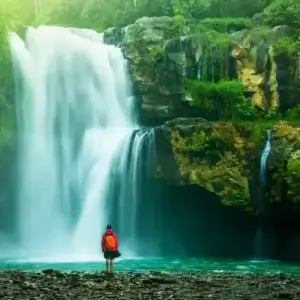
With something for everyone, this slightly smaller country is perfect for adventurous backpackers. You’ve got everything from volcanos to heritage architecture to hot springs – the list is almost endless. Spanish is the official language, and the currency is the US Dollar.
Starting with the capital, Quito, every tourist should straddle the equator at least once. Other top spots for backpacking in Ecuador include:
- Otavalo Market – the largest marketplace in South America, so you can get your haggle on
- Galapagos Islands – it may be a bit pricey, but you’ve come too far not to visit one of the world’s most diverse and untouched natural wonders
- The Amazon – a classic destination throughout South America, but Ecuador is known as the cheapest place to visit the Amazon
- Quilotoa Loop – a spectacular, high-altitude trek around the crater of a volcano.
Safety tips: There is a risk of violent crime and theft in Ecuador due to organised crime.6 Keep up to date with any advice from the Ecuadorian government as the situation can change suddenly. Criminals can also target tourists, so be careful when travelling alone or at night, especially if you’re a female traveller.
Peru
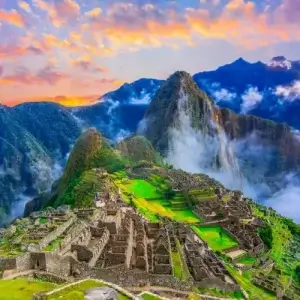
Famous for the Incans, llamas and their cocoa trade, Peru’s the epicentre of cultural tourism. Spanish and Quechua are the official languages in Peru, though Quechua is more prevalent in highland areas.
The currency is Peruvian Nuevo Sol (soles), but USD is also accepted in some places. Starting in Lima, take in some of the region’s unique local cuisine and cliffside views.
Top spots for backpacking in Peru include:
- Machu Picchu – a ruined Incan citadel that hikers can reach by trekking the Inca Trail or taking an overnight train
- Larco Museum – located in Lima, this museum is famous for its exhibit of pre-Incan pottery
- Huacachina – palm tree ringed lagoon oasis, complete with sand boarding
- Puno and Lake Titicaca – the lake is the largest (by volume) in South America
- Tarapoto – a jungle city on the edge of the Peruvian rainforest
- Cusco – the capital of the Incan empire and a great place to haggle for souvenirs.
- Colca Canyon – the second-deepest canyon in the world, with tours leaving from the city of Arequipa.
Safety tips: Never hail taxis from the street, use reputable companies only and, when driving, always lock the doors and windows.7 Some tour and adventure activity operators don’t follow proper safety protocols; always ask about safety requirements and use available safety gear.
Venezuela
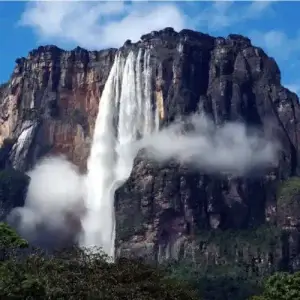
Venezuela is known for its natural wonders and for being a tropical paradise. The national currency is the Venezuelan bolívar, and the primary language is Spanish.
Starting in Caracas, take in the Cathedral Metropolitana, Museo Sacro de Caracas and El Ávila National Park. Don’t forget to try an arepa (famous Venezuelan corn meal cake) and cool down with a refreshing papelón con limón (raw hardened sugar cane with water and lemon or lime juice).
Some of Venezuela’s top spots for backpacking include:
- Cueva del Guácharo – a national park centred around a 10km long limestone cave, complete with bats
- Maracaibo palafitos – a traditional ‘floating’ village of stilted houses on a peaceful 20-million-year-old lake
- Angel Falls – the highest uninterrupted waterfall in the world
- Merida – the highest city in the Venezuelan Andes, a university town and the country’s only ski resort.
Safety tips: Smartraveller has a ‘Do Not Travel’ warning for Venezuela due to the unstable political climate (current as of 21 February 2024).8 If you do travel, be aware there are shortages of food and water, and pharmacies are currently not stocking basic medication.
The lesser-known South American countries
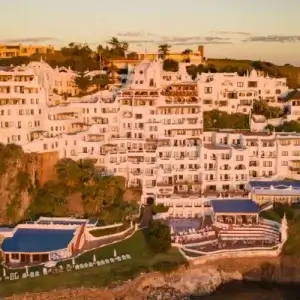
Guyana, Suriname, Paraguay and Uruguay are lesser known, but no less exciting countries you may want on your South American backpack itinerary. Guyana and Suriname are located on the continent’s north-eastern tip and are bordered by the Caribbean Ocean.
If you’re looking for some of the best beaches in South America that aren’t packed with tourists, backpacking in Guyana or Suriname could be ideal. There are many wonderfully preserved colonial heritage architecture, museums and lush landscapes.
Paraguay and Uruguay are also great ‘off the beaten track’ destinations for international tourists. Check out Punta del Este in Uruguay, a summer oasis often compared to St. Tropez, and do a wildlife cruise down the Paraguay river through the wetlands.
Meet our travel insurance expert, Adrian Taylor
As a General Insurance expert with over 13 years’ experience in financial services, Adrian Taylor believes in educating customers about the importance of travel insurance so that anyone can kick back and make the most of their time away from home. While no one wants a disrupted holiday, a suitable travel insurance policy can provide a financial safety net for yourself, your belongings and your trip in case things go wrong.
Want to know more about travel insurance?
1 Smartraveller, Department of Foreign Affairs and Trade. Argentina. Last updated October 2022. Accessed March 2023.
2 Smartraveller, Department of Foreign Affairs and Trade. Bolivia. Last updated February 2023. Accessed March 2023.
3 Smartraveller, Department of Foreign Affairs and Trade. Brazil. Last updated February 2023. Accessed March 2023.
4 Smartraveller, Department of Foreign Affairs and Trade. Chile. Last updated February 2023. Accessed March 2023.
5 Smartraveller, Department of Foreign Affairs and Trade. Columbia. Last updated October 2022. Accessed March 2023.
6 Smartraveller, Department of Foreign Affairs and Trade. Ecuador. Last updated February 2023. Accessed March 2023.
7 Smartraveller, Department of Foreign Affairs and Trade. Peru. Last updated February 2023. Accessed March 2023.
8 Smartraveller, Department of Foreign Affairs and Trade. Venezuela. Last updated January 2023. Accessed March 2023.


